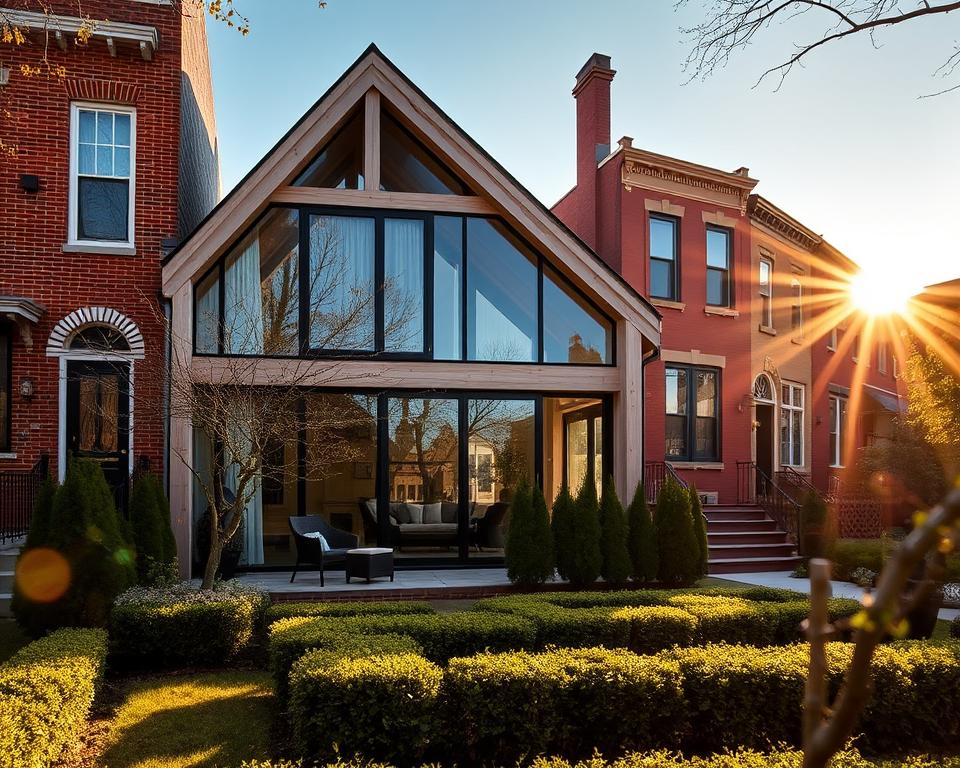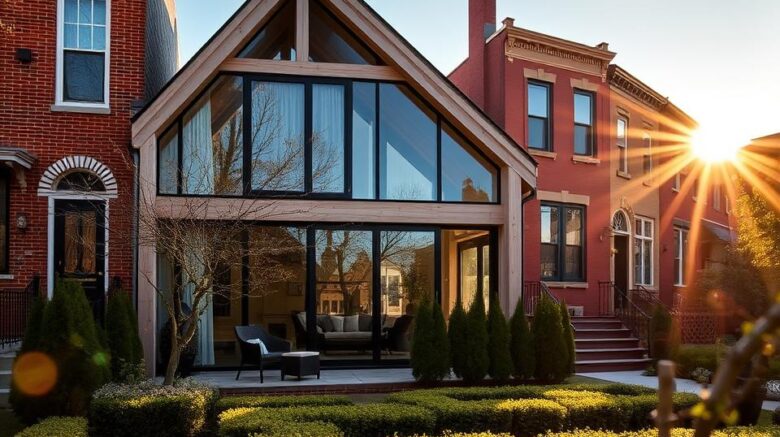Earth Bound Building: Straw-bale Homebuilding in Montgomery
Have you heard how houses constructed from green materials can reduce energy costs by up to 50%? It’s one key reason why a growing number of homeowners are turning to eco-conscious design. Earth Bound Building, serving Montgomery, is at the forefront of this movement, focused on innovative and energy-efficient projects.
Through the use of natural materials such as straw bales in timber frames, Earth Bound Building delivers natural building construction Montgomery that remain not only planet-conscious but also remarkably durable. The team’s approach integrates traditional craftsmanship with modern ecological practices, so every project achieves the top standards of sustainability.
What sets Earth Bound Building apart comes from their craftsman-led method and strong community involvement. They work closely with homeowners to craft spaces that match their values and needs. If you’re looking for a more sustainable way to build, Earth Bound Building is your go-to partner in Montgomery.
About Straw bale Building?
Straw, commonly considered waste, is transforming green building. Building with straw bales utilizes stacking bales in timber frames to form walls that are simultaneously insulating and structural. This method repurposes an agricultural byproduct, making it a sustainably sourced and earth-friendly choice.
Straw is derived from grain crops such as wheat, rice, or barley. Instead of burning or discarding it, farmers often provide it for construction. This reduces agricultural waste and supplies a sustainable material for homes. It’s a simple process, well-suited to owner-builders and community projects.
One of the notable features of straw bale walls is their insulation performance. Compared to traditional materials such as fiberglass or wood, straw bales have a higher R-value. That means they hold heat better, leading to reduced energy costs. Below is a quick comparison:

| Material | R-Value per inch |
|---|---|
| Strawbale | R-2.38 |
| Fiberglass | R-2.20 |
| Wood | R-1.41 |
Another plus is the use of low-toxin materials. Straw bales are absent of harmful chemicals, promoting cleaner indoor air quality. That makes them a wise choice for families and green-minded homeowners.
In summary, straw bale construction is a low-impact, energy-efficient, and wellness-minded option. It’s a perfect fit for those looking to reduce their environmental footprint while enjoying long-term savings.
Why Select Earth Bound Building for Your Project?
Selecting the right team for your eco-friendly project matters greatly. Earth Bound Building is a leader in eco-friendly design, delivering innovative solutions customized for your needs. Our approach combines state-of-the-art techniques with a deep respect for the environment.
Commitment to Sustainability
Earth Bound Building emphasizes sustainable practices in every project. They use CO₂-locking straw and reduced-impact materials to minimize environmental impact. Beyond helping the planet but also supports long-term savings for homeowners.
Their collaborations with regional farmers guarantee ethically sourced materials. By strengthening local agriculture, they reinforce a circular economy. This commitment to sustainability differentiates them in the industry.
Local Expertise in Montgomery
With longstanding ties in Montgomery, Earth Bound Building knows the unique needs of the area. They are experienced in local climate conditions, permitting processes, and supply chains. This expertise ensures smooth project execution and compliance with regulations.
Their site-specific designs reflect Montgomery’s aesthetic preferences while satisfying strict building codes. Whether it’s a residential or commercial project, they produce results that harmonize with the local environment.
| Focus | Earth Bound Building | Conventional Methods |
|---|---|---|
| Material Sourcing | Local, ethically sourced straw | Imported, high-embodied energy materials |
| Energy Efficiency | High R-value insulation | Standard insulation |
| Environmental Impact | Low carbon footprint | Higher emissions |
Earth Bound Building’s focus to sustainability and local expertise makes them a natural fit for your next project. Their modern practices and community-focused approach ensure a seamless and eco-friendly experience.
The Advantages of Strawbale Construction Montgomery
Eco-friendly design is growing rapidly for its ability to combine innovation with environmental responsibility. One of the most compelling methods in this field is the use of straw bales. This approach offers a range of benefits, from energy efficiency to eco-friendliness, making it an appealing option for modern homeowners.
Energy Efficiency and Cost Savings
Straw bale walls deliver outstanding insulation, outperforming traditional materials like fiberglass. With an R-value of 2.38 per inch, they stabilize indoor temperatures, cutting the need for heating and cooling. This can lead to energy savings of up to 50-75%.
Over time, these savings can offset the initial construction costs. Homeowners enjoy lower energy bills while contributing to a greener planet. Here is how straw bales measure up to other materials:
| Material Type | R-Value per inch |
|---|---|
| Straw Bale | R-2.38 |
| Fiberglass | R-2.20 |
| Wood | R-1.41 |
Eco-Friendly and Renewable
Straw is a annually renewing resource that is harvested every year, unlike timber, which takes decades to mature. Using straw in construction cuts down on agricultural waste and promotes a circular economy. It also stores CO₂ in the walls, contributing to fighting climate change.
Additionally, straw bale walls are non-toxic, enhancing indoor air quality. They are also resistant to fire, with plastered walls surpassing 2-hour fire ratings. This makes them a dependable and eco-friendly choice for any project.
By choosing straw bale construction, you’re not just building a home—you’re committing to a more wholesome, more sustainable future.
How Straw bale Homes Are Constructed
There are several ways to construct sustainable homes using straw bales. Each method offers unique benefits, from structural support to faster installation. Understanding these approaches can help you decide on the best approach for your project.
Nebraska Style vs. In-Fill Wall Systems
The Nebraska Style is a traditional method where straw-bale walls serve as the primary structural support. This approach is well-suited for smaller homes and focuses on simplicity. The bales are stacked directly on the foundation, reducing the need for the need for additional supports or frames.
In contrast, In-Fill Wall Systems use timber frames to take the structural load. The bales are placed within these frames, allowing for faster roof installation and greater design flexibility. This method is preferred for larger projects where customization is key.
Prefabricated Straw Wall Panels
Prefabricated panels are a contemporary innovation in straw bale construction. These factory-built panel sections minimize on-site work and minimize weather-related risks. They are designed for quick assembly, making them a practical choice for time-sensitive projects.
Here is a comparison of the three methods:
| Approach | Key Features | Ideal For |
|---|---|---|
| Nebraska Style | Load-bearing bales, simple method | Small homes |
| In-Fill Systems | Timber frames, design flexibility | Larger projects |
| Prefabricated Panels | Factory-built, reduced on-site work | Quick installations |
Each method has its strengths, and the choice hinges on your project’s needs. Whether you prefer traditional techniques or modern innovations, straw bale construction offers a responsible and effective solution.
Common Myths About Straw bale Construction
Many people hold myths around sustainable materials like straw. These myths often deter homeowners from exploring eco-friendly options. Let’s debunk some of the most common concerns.
Fire Resistance and Safety
One of the biggest myths is that straw is a fire hazard. In reality, compressed bales lack the oxygen needed to burn. Lab tests demonstrate that plastered straw walls can withstand more than two hours of fire exposure. This outperforms the fire resistance of many traditional materials like lumber.
Plaster acts as a protective barrier, enveloping the bales and preventing ignition. This makes straw-based structures safer than many people assume. Here’s a quick comparison:
| Material | Fire Rating |
|---|---|
| Straw (plastered) | 2+ hours |
| Wood | 1 hour |
Pest and Moisture Management
Another concern is pests. Straw has no nutritional value, which discourages rodents and insects. When sealed with plaster, it becomes extremely difficult for pests to penetrate. This removes one of the most common worries homeowners worry about.
Moisture is also manageable with proper design. Elevated foundations, wide eaves, and breathable finishes like vapor-permeable stucco prevent rot. Modern techniques support that these houses remain durable for decades.
Compare how straw compares to traditional materials in moisture control:
| Assembly | Moisture Control |
|---|---|
| Straw with Proper Design | High |
| Wood without Treatment | Low |
By countering these myths, it’s clear that straw-based structures are a sound, eco-friendly, and enduring choice for modern homes.
Is a Strawbale Home Right for You?
Creating a home that’s both aesthetic and green is well within reach. With unique features like deep window niches and sweeping designs, eco-friendly homes deliver endless possibilities. Consider why this could be the perfect choice for you.
Customization and Aesthetic Appeal
One of the signature features of these homes is their design flexibility. You can create organic walls, arched doorways, and built-in shelving to match your style. The thick walls also deliver strong acoustic privacy, making your space peaceful and quiet.
Rustic plaster finishes lend a unique charm, combining modern aesthetics with natural elements. Whether you’re an artist or an eco-conscious family, these homes can be tailored to reflect your personality and needs.
Long-Term Benefits and Sustainability
Selecting a sustainable home isn’t just about the environment—it’s also a smart financial decision. These homes cost less to maintain over time, thanks to their energy efficiency. With lower heating and cooling bills, you’ll see significant savings on utilities.
Additionally, green homes can receive tax incentives and have higher property values. Below is a quick comparison of lifecycle costs:
| Aspect | Straw Bale Homes | Conventional Homes |
|---|---|---|
| Utilities | Lower | Higher |
| Upkeep | Minimal | Regular |
| Resale Value | Higher | Standard |
Earth Bound Building’s discovery process makes sure your goals match your budget. Whether you’re seeking an off-grid retreat or a family home, they’ll support you every step of the way.
In Summary
Adopting eco-friendly living is powered by the right materials and the right team. Straw bale homes provide unmatched benefits, from energy efficiency to resilience. They reduce costs while helping the environment, which makes them a forward-thinking choice for modern homeowners.
Earth Bound Building leads the way in sustainable building in Montgomery. Their expertise delivers every project achieves the highest standards of quality and sustainability. Choose to join the growing community of homeowners who’ve adopted this innovative approach.
Prepared to move forward? Speak with Earth Bound Building for a tailored consultation. Take part in their workshops or visit completed projects to see the benefits firsthand. Building with straw bale not only creates a house but also bolsters regenerative agriculture and local economies.
